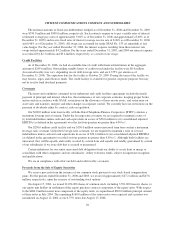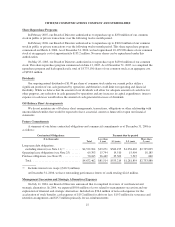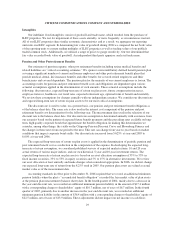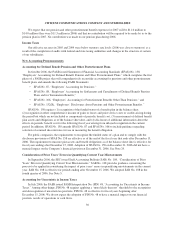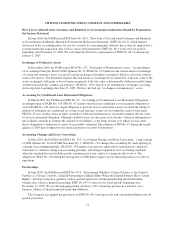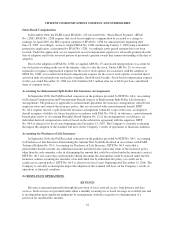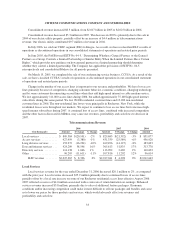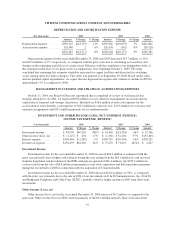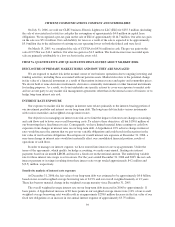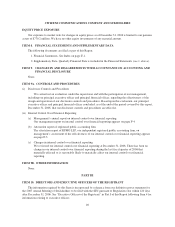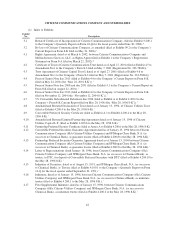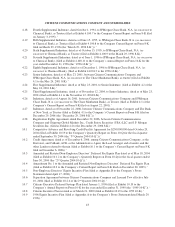Frontier Communications 2006 Annual Report Download - page 35
Download and view the complete annual report
Please find page 35 of the 2006 Frontier Communications annual report below. You can navigate through the pages in the report by either clicking on the pages listed below, or by using the keyword search tool below to find specific information within the annual report.CITIZENS COMMUNICATIONS COMPANY AND SUBSIDIARIES
Local services revenue for the year ended December 31, 2005 decreased $21.4 million or 3%, as compared
with the prior year. This decline is comprised of $18.8 million related to the continued loss of access lines and
$4.0 million related to a reserve associated with state rate of return limitations on earnings. Enhanced services
revenue increased $5.9 million, as compared with the prior year, primarily due to sales of additional product
packages.
Access Services
Access services revenue for the year ended December 31, 2006 decreased $3.4 million or 1%, as compared
with the prior year. Access services includes both switched revenue and subsidy payments. Switched access
revenue decreased $13.9 million to $263.4 million. Approximately $24.0 million of the switched access decline
was attributable to a decline in minutes of use related to access line losses. This decline was offset by
approximately $9.3 million of disputed carrier activity resolved in the Company’s favor during the fourth quarter
of 2006. Subsidies revenue increased $10.5 million to $164.6 million primarily due to increased receipts from the
federal high cost fund due to higher costs in the base year, as well as increased receipts from state high cost
funds.
Access services revenue for the year ended December 31, 2005 decreased $25.6 million or 6%, as compared
with the prior year. Switched access revenue decreased $9.7 million, as compared with the prior year period,
primarily due to a decline in minutes of use. Access service revenue includes subsidy payments we receive from
federal and state agencies. Subsidy revenue decreased $15.9 million primarily due to decreased Universal Service
Fund (USF) support of $19.2 million because of increases in the national average cost per loop (NACPL) and a
decrease of $2.0 million related to changes in measured factors, partially offset by an increase of $6.4 million in
USF surcharge rates.
Increases in the number of Competitive Eligible Telecommunications Companies (including wireless
companies) receiving federal subsidies, among other factors, may lead to further increases in the NACPL,
thereby resulting in decreases in our subsidy revenue in the future. The FCC and state regulators are currently
considering a number of proposals for changing the manner in which eligibility for federal subsidies is
determined as well as the amounts of such subsidies. The FCC is also reviewing the mechanism by which
subsidies are funded. Additionally, the FCC has an open proceeding to address reform to access charges and
other intercarrier compensation. We cannot predict when or how these matters will be decided nor the effect on
our subsidy or access revenues. Future reductions in our subsidy and access revenues are not expected to be
accompanied by proportional decreases in our costs, so any further reductions in those revenues will directly
affect our profitability and cash flows. We currently expect that as a result of an increase in the national average
cost per loop, a decrease in our cost structure and the elimination of high speed internet from the calculation of
the FCC’s USF surcharge (which has a corresponding decrease in operating expenses) there is likely to be a
decrease in the total subsidy revenue earned in 2007 and such decrease may be significant in relation to the total
amount of our subsidy revenue.
Long Distance Services
Long distance services revenue for the years ended December 31, 2006 and 2005 decreased $16.2 million or
10% in 2006 and $14.1 million or 8% in 2005, primarily due to a decline in the average rate per minute. Our long
distance minutes of use increased during 2006. We have actively marketed bundles or unlimited use of long
distance minutes particularly with our packages of multiple services. The sale of bundled and unlimited minutes
has resulted in an increase in minutes used by our long distance customers and has had the effect of lowering our
overall average rate per minute billed. Our long distance revenues may continue to decrease in the future due to
lower rates and/or minutes of use. Competing services such as wireless, VOIP and cable telephony are resulting
in a loss of customers, minutes of use and further declines in the rates we charge our customers. We expect these
factors will continue to adversely affect our long distance revenues during 2007.
34




